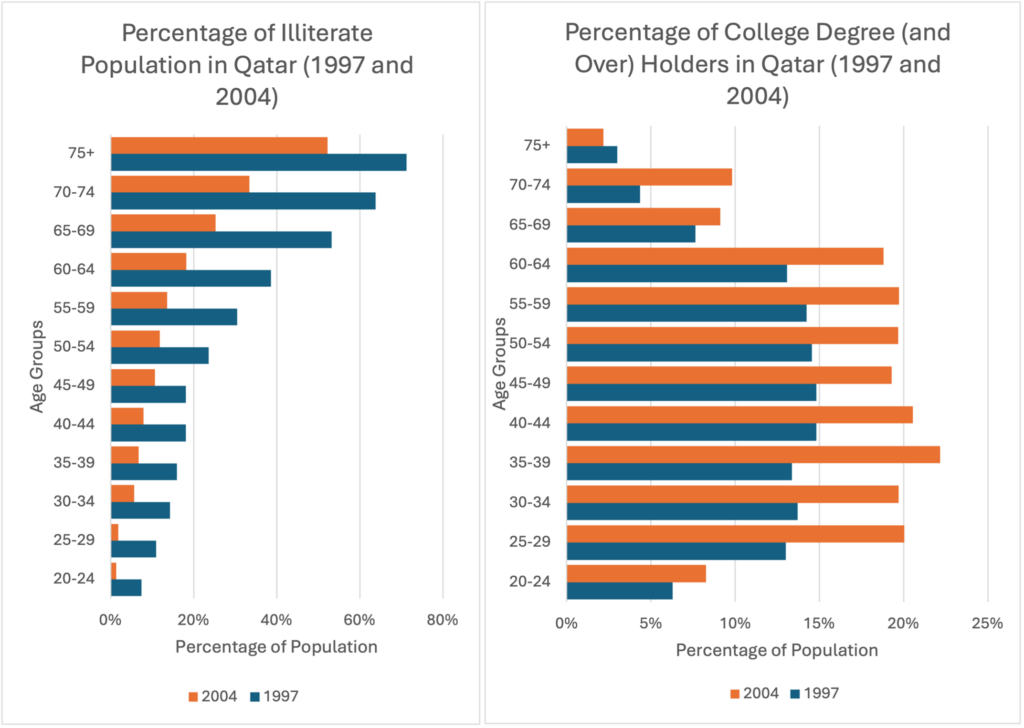By Shine Min Thant
Qatar, a small yet influential state in the Middle East, is a very interesting case study for demographic research because of its rapid development over the past thirty years. Qatar occupies a peninsula only slightly larger than the U.S. state of Rhode Island that juts out into the Persian Gulf from its border with Saudi Arabia. The country has experienced relatively rapid economic growth since the late 20th century, mainly due to its vast reserves of natural gas and oil. This newfound wealth allowed Qatar to invest heavily in its healthcare, infrastructure, and education – therefore making the country an ideal case study for social change and development. Additionally, a recent surge in Qatar’s immigrant population (which constitutes over 78 percent of the population) also makes it an ideal country to study social mobility and social change.
As part of the ISRDI Diversity Fellowship Program, I worked with Dr. Tracy Kugler, Professor Steven Manson, Professor Evan Roberts, and undergraduate student Rawan AlGahtani on a project to examine Qatar’s change using census data from 1984, 1997, and 2004. Summary tables from all three censuses were previously only available as printed documents. As a first step, we needed to transform the data from a hard-to-get printed format to widely accessible IPUMS IHGIS format. This process included multiple steps from conducting optical character recognition (OCR) to conducting data quality checks using R scripts (Figure 1).
Figure 1: IPUMS IHGIS Workflow
Data and Insights
Census results from both 1997 and 2004 include tables of educational attainment by age group, allowing us to see change over time. For simplicity, we focus here on the extremes of the educational spectrum—illiteracy and college degree or above—for ages 20 and over (Figure 2). Illiteracy rates declined dramatically over the seven years, especially among age groups 65 years and over. Similarly, rates of completion of college degrees are much higher in 2004 than in 1997 for ages 20 and above.
Figure 2: Illiteracy and College Completion Rates in Qatar [1997 and 2004] from IHGIS
When considering changes in education across this time in Qatar, it is important to consider changes in the population composition of the country, particularly changes from migration. According to the World Bank, Qatar’s population rose from 550,591 in 1997 to 777,943 in 2004 (a whopping 41.3 percent increase). In comparison, the population of the United States only grew around 7.4 percent from 1997 to 2004. This population growth in Qatar, largely fueled by an influx of international migrants, combined with an increase in global literacy rates, reshaped the socio-demographic profiles of the country.
In addition, targeted educational reforms and investments in education also likely played a major role in improving literacy and college graduation rates. For example, in 1995 (two years before our initial data), Qatar launched a landmark education initiative called Education City that established a multi-university campus that brought prestigious international universities to Qatar. This initiative not only expanded higher education opportunities but also introduced diverse educational philosophies and practices. Another example is Qatar’s Basic Education Reform in the early 2000s aimed at primary and secondary education. This reform introduced independent schools designed to foster autonomy and accountability. The reform also modernized curriculum, teaching methods, and school governance, aligning them more closely with international standards.
Conclusion
Since 2004, Qatar has continued to grow and develop with initiatives like the World Innovation Summit for Education (WISE) in 2009, which brought global attention to Qatar’s commitment to education reforms. These efforts, alongside the country’s significant demographic shifts and investment in education make Qatar a compelling case study for studying the impacts of immigration, policy reform, and education development.
The first ever digital data for Qatar’s 2004 census are now available from IPUMS IHGIS.


